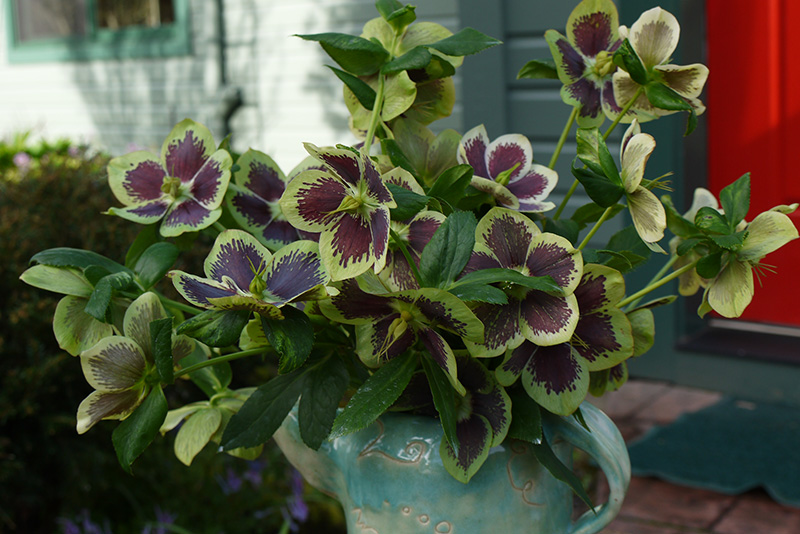Hellebore Care Instructions
Cultivation
Hybrid hellebores (Helleborus X hybridus) are very tolerant and will grow well in most soils as long as the ground is not extremely dry or stagnantly waterlogged, although they usually survive even those conditions. They prefer a sheltered position in semi-shade (dense shade can reduce flowering) with a rich, moist, free draining soil. If possible, it is desirable to plant hellebores on a sloping bed, both to improve drainage and also to make it easier to look into the flowers, which naturally nod. All hellebores are deer proof.
Soil Type
Although very tolerant of soil type, hellebores are deep-rooted and to flower at their best, they appreciate plenty of nutrients and adequate moisture. They will benefit from being planted in deeply dug soil improved with plenty of humus, in the form of leaf mold, compost, or old manure. We mulch once a year in winter with a local compost called Steer Plus, but be careful to not bury the crown of the plant with mulch.
Remove Old Foliage and Stems
Remove the old faded flower stems, unless you require seed, or you will have an excess of seedlings beneath your mother plant. Remove all foliage from hybrid hellebores and the deciduous species in December or January. This is done to improve the appearance of the plant (the old leaves eventually die, slowly), making it easier to see the flowers and also prevent the spread of any existing disease to the newly emerging flower stems and leaves.
Disease and Pests
Hellebores are generally trouble-free and easy-to-grow plants. Some of the occasional problems that they may experience are fungal diseases, aphids, and slug or snail damage. We do not spray against fungus in the garden, but prefer to cull plants that show weakness to disease. If aphids become a significant problem there is a spray sold by Gardens Alive called Pyola Oil or Take Down, available on Amazon, that is a mixture of pyrethrins and canola oil that is very effective and is acceptable to organic growers.
Division
Hellebores are typically long-lived plants. The regular mulching helps keep them healthy and free-flowering. They do not usually need to be divided for the health of the plant, but if you wish to transplant or divide a hellebore, that is best done in September or October. Dividing is best accomplished by digging the whole plant, washing the crown free of soil in order to make it easier to see what you are doing, and then cutting between the growth buds with a sharp knife. If you leave at least three buds in each division, the plant will recover more quickly.
Seed Sowing
Sow hellebore seed as soon as possible (preferably in June to August). We use a mix of 75% Black Gold® and 25% perlite. Sow the seed thinly and cover with 1/4″ (6mm) layer of #2 chick grit (obtainable at any feed store). Leave the pot out in the open, not in direct sun, and do not allow them to dry out. When germination has occurred, bring them into a cold frame or cool greenhouse, taking care against possible damage from slugs or mice. Transplant into small pots when the first true leaves appear and they are large enough to handle. We use 4″x4″x6″ band pots and a product called Patio Potting Soil formulated by a local forest products company, Rexius. Pot on as required. Liquid feed regularly from about six weeks after potting on.
Cut Flowers
Linda Beutler and her commercial floral design students impart their wisdom below with the best way to preserve your Helleborus X hybridus blooms.
Cut Hellebore Water Recipe:
In a quart of water, add one packet (which equals one level, not heaping) tablespoon of commercial floral preservative, and 2 tablespoons of ethyl alcohol. NOTE: the CCC students used ethyl alcohol containing acetone. For the next best results you could swap isopropyl alcohol for ethyl alcohol (95% ethyl alcohol is available at Oregon Liquor stores). Use only mature flowers with seed already forming.

Tips:
- Leave the hellebore stems as long as possible and harvest the stems when the nectaries have fallen off the primary (first to open flower, with secondary buds open or opening).
- Always cut the ends of any cut plant stems at an angle.
- Don’t be skimpy with the water; you want at least half of the stem length submerged. In our experiments we used vases that held a quart of solution. Helleborus X hybridus stems don’t have bark or a tough outer sheath so some water/solution will be absorbed through the sides of the stems as well as being drawn up the cut end.
- Don’t overdose the formula be adding more commercial preservative of alcohol. This isn’t like cooking with garlic—more is not better.
- If the hellebore stems develop a “cooked” looking cut end after a week or so, simply pull them from the water and cut that portion of the stem off.
- If you don’t have commercial preservative, you will still notice better vase life for hellebores by just using the alcohol, still only 2 T. per quart of water.
